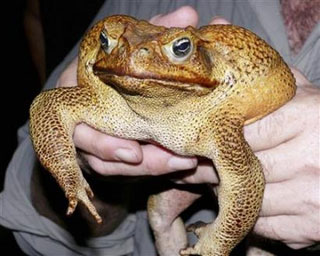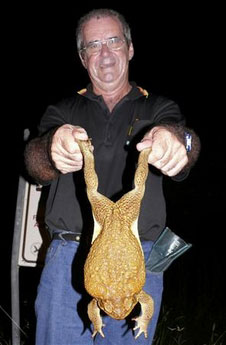Photos of monster cane toad captured in Australia
Photos of monster cane toad captured in Australia
mongabay.com
March 27, 2007
A conservation group captured a giant cane toad in the Australian city of Darwin. The beast weighed 840 grams (1.8 pounds) and measured 20.5 cm (8 inches).
The toad was captured as part of a publicity-seeking round up of the amphibian which is considered a problematic invasive species in Australia. The poisonous toad has wreaked ecological havoc on native species and killed pets and livestock.
Introduced from Hawaii in 1935 at the urging of sugar cane growers in Queensland who were suffering from an infestation of crop-damaging beetles, the cane road rapidly established itself as one of the most costly alien invasive species in the history of Australia. Not only did the cane toads fail to control the beetle outbreak — they couldn’t jump high enough to eat the insects — they feasted on Australia’s rare and endemic birds, reptiles, amphibians, and small mammals.
 Bob Goninon of FrogWatch Australia holds a large cane toad captured near Darwin in Australia’s Northern Territory March 26, 2007. Courtesy of FrogWatch |
FrogWatch, an Australian environmental group, aims to end the species’ reign by capturing and killing all cane toads in the country.
FrogWatch coordinator Graeme Sawyer told the Associate Press that captured toads are an excellent fertilizer.
“We kill them with carbon dioxide gas, stockpile them in a big freezer and then put them through a liquid fertilizer process” that renders the toads nontoxic, Sawyer said.
“It turns out to be sensational fertilizer,” he added.
Cane toads are originally from northern Venezuela and Guyana but the species has become a menace across much of the southern United States, Hawaii, and the Caribbean. The species has gained fame for both its size and toxicity. Some have claimed the frog’s secretions are hallucinogenic but there is no evidence that the species has actually produced any sort of high in humans.
 Bob Goninon of FrogWatch Australia holds a large cane toad captured near Darwin in Australia’s Northern Territory March 26, 2007. Courtesy of FrogWatch |
Related article
Overstaying Their Welcome: Cane Toads in Australia.
About a week ago, an Australian Minister of Parliament from the Northern Territory sparked outrage from animal welfare groups, and probably a chuckle of recognition and commiseration among everyone else, with his comments on cane toads. David Tollner, the lawmaker in question, urged people on Australian radio to club toads to death with golf clubs and cricket bats, remarking these methods were commonplace when he was a young man, and he had partaken in such activities himself. For anyone who has had to deal with these insufferable creatures, they know where Tollner is coming from, even if they do not agree with his method of extermination.